'For us, snow leopards are deities': The farmers protecting Nepal's snow leopards
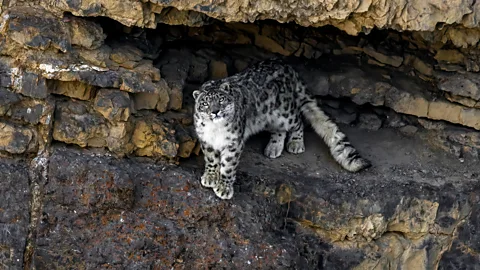 Getty Images
Getty ImagesIn the Himalayas of Nepal, snow leopards often prey on livestock and face retaliation from humans. A group of Nepali women have developed a simple solution to help keep both livestock and the predators alive.
In the stillness of a winter's night, a snow leopard slunk into the livestock enclosure on Rinchen Lama's farm. This big cat was out hunting, high in the hills of Dolpa, a Himalayan district in western Nepal. Everyone who lives in Dolpa can tell you about snow leopards – they are powerful predators. Those farm animals didn't stand a chance.
Rinchen remembers the scene the following morning: "There was wool everywhere, matted with blood. I lost 37 sheep and goats that night, almost my entire livelihood."
And then, a few months later, another attack. A snow leopard killed Rinchen's horse. Such losses are not easy to forget. "We've been told conserving snow leopards is important, but for communities like ours, they make life very difficult," he says.
Snow leopards (Panthera uncia) are elusive creatures that inhabit the mountain ranges of 12 Asian countries. They like the high life. The big cats are generally found at altitudes between 3,000 and 5,000 metres (9,843-16,404ft) above sea-level, where they are the apex predators in the habitats they prowl. But they are also rare and secretive, making estimating their population difficult. But the creatures are listed as vulnerable by the International Union for Conservation of Nature (IUCN).
The last assessment of global snow leopard numbers in 2016 estimated that species population numbered between 2,700 and 3,300, though some estimates range as high as 7,000, according to the IUCN. Recent studies have also suggested that their population density may be far lower than previously estimated.
Snow leopard numbers are thought to be declining partly as their wild prey – the goat-like blue sheep or bharal, ibex, pika and hares – have been replaced by livestock, which are then killed by the predators instead. Domestic horses in particular have become an important food source for snow leopards in some areas. But it has also come with consequences.
Farmers who lose livestock to snow leopards – and so face the loss of their livelihood – sometimes choose to kill these cats in an attempt to prevent further attacks. But a pioneering conservationist in Nepal is working to change attitudes. And she couldn't do it without the help of local women.
 Eileen McDougall
Eileen McDougallDespite growing awareness around the importance of wildlife conservation, snow leopard killings by humans are considered a significant threat to these creatures. One recent report from Traffic, a non-governmental organisation that tracks global trade in wildlife and plants, estimated that each year between 221 and 450 are killed globally, and 55% of these in retaliation for predation of livestock.
A devastating predator
It might seem shocking to some that an animal as vulnerable and majestic as the snow leopard could be the target of killings. But the people who live in those places most threatened by these big cats tend to be very poor, the soil on their farms is infertile, and nearby infrastructure is sparse.
Rinchen's farm, for example, is part of a tiny Himalayan hamlet, in a valley flanked by tall rocky cliffs. As in other communities in Nepal, the people here share their scarce pasturelands with many wild animals, including musk deer, Tibetan wolves and bharal.
The snow leopards do not have as much wild prey to hunt as they once did, meaning they often attack domestic animals. Rinchen's story, of a snow leopard killing many sheep and goats in an enclosure overnight, is a catastrophe for a Himalayan herder. Incidents like this fuel the ongoing conflict between the leopards and locals. And such attacks are surprisingly common.
One study published in 2020 found that each household in the high-altitude, ethnically-Tibetan area of Dolpo or Upper Dolpo – itself an area within the district of Dolpa – lost, on average, four domestic animals to snow leopards in one year. The resulting financial loss, of around 120,000-140,000 Nepali rupees (£690-£870/$900-1,050), is roughly equivalent to the average person's annual income in western Nepal.
"I have travelled to every corner of Dolpo taking surveys with herders," says Nepali conservationist Tshiring Lhamu Lama. "I have lots of records detailing mass killings of their livestock." But by giving local people a stake in the animals' conservation, Tshiring argues they will gradually come to understand the value of conservation. Indeed, studies suggest that support for the snow leopards is high among herders in other parts of Nepal and only a minority believe killing the animals is a solution.
Conflict resolution
Tshiring says the main way to reduce retaliatory killings of snow leopards is to minimise the mass night-time killings of livestock, which remains the greatest source of tension between locals and wild animals. To that end, supported by the Snow Leopard Conservancy, a non-profit, she has provided outdoor, battery-powered lights to around 100 farmers and hopes to distribute them to around 500 more.
These devices emit colourful lights at night, which deter snow leopards. They are portable, durable, charge up using solar energy, and at night are easily fixed on a pole near to traditional livestock enclosures, also known as corrals. However, the lights are only a short-term solution. After a few years of exposure to them, the snow leopards learn to ignore them.
Playing radios and burning dung have also proved effective for deterring snow leopards from farms at night, says Rinzin Phunjok Lama, a conservation biologist and founder of UKALI, an organisation that works in community-based biodiversity conservation in western Nepal.
However, both Rinzin and Tshiring agree the best long-term strategy for reducing mass killings of livestock is to make livestock enclosures or corrals predator-proof. Corrals in Dolpa tend to be roofless structures with low walls, which keep the livestock herd together but do not keep snow leopards out. So, in early 2024, Tshiring, along with local herders from the remote village of Tilling, designed and built Dolpa's first leopard-proof corral.
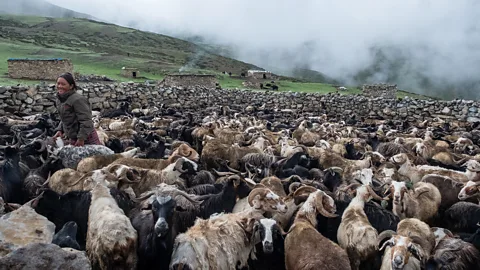 Eileen McDougall
Eileen McDougall"At first, I proposed a rammed-earth construction, as I saw that all the houses in Upper Dolpo are made of locally available clay and soil," she explains. However, the locals disagreed, telling her that increased rainfall, caused by climate change, sometimes erodes these rammed-earth foundations in their own houses. Tshiring decided to use a stone foundation instead. It also means there is no chance of the snow leopards tunnelling in.
Women are able to transport the materials needed to build these hardened corrals. This is important because men are often absent, as they leave villages to trade, so women must take care of the livestock. "Women are the main people who have to deal with the snow leopards – so they must be involved," stresses Tshiring.
Individual pieces of metal required for the corrals were less than five feet (1.5m) in length and transported from Kathmandu to Upper Dolpo. There, local women herders weaved wire into sections of mesh fencing, and then fixed these structures to a metal frame. The construction, Tshiring hopes, will provide a model for other communities in the area.
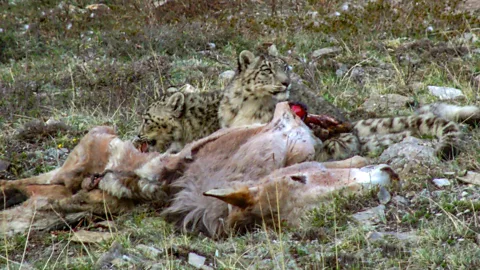 Tshiring Lhamu Lama
Tshiring Lhamu LamaA similar approach in Hemis National Park in Ladakh, a Himalayan region in northern India home to around 500 snow leopards, proved highly successful in reducing mass killings of livestock.
Since 2001, led by Snow Leopard Conservancy India Trust India, a community-based conservation organisation, locals have constructed nearly 200 predator-proof corrals, first in Hemis and then in other areas. These designs used wire-mesh and wooden beams. It helped to cut the number of mass livestock killings from 5.5 to 0.5 per year.
And in the flat plains of the Southern Gobi desert in Mongolia, researchers erected a simple 2m (6.6ft) tall wire fence around an old stone corrals as part of a study, the results of which were published in 2020. These fences proved highly effective in terms of preventing night-time killings of livestock.
Value generation
According to Ghana Gurung, director of the World Wide Fund for Nature (WWF) in Nepal, as long as livestock graze in the snow leopard's habitat, it will be impossible to stop all predation by these big cats. He suggests that herding practices be improved, but also adds that farmers must tolerate some smaller livestock losses. Domestic animals have always made up a significant proportion of snow leopards' diets, he says.
Research has also found both wild and domestic prey to be crucial to a snow leopard's diet, with the numbers of wild prey positively tied to the size of snow leopard populations. However, studies have failed to identify if the abundance of wild prey has any effect on levels of livestock predation by snow leopards, indicating it may not be as simple as increasing wild prey numbers to control levels of livestock depredation.
"For us, snow leopards are deities who are protecting the ecosystem of the mountains. If you anger them, then they will kill more," Gurung explains. "Losing one or two of your livestock is OK, it keeps the deity happy." There must, however, be an alternative source of income that compensates for continued losses, he says.
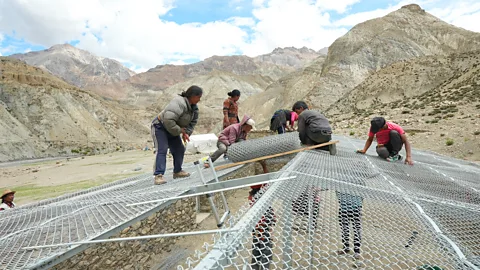 Tshiring Lhamu Lama
Tshiring Lhamu LamaTshiring hopes to source additional funds from snow leopard tourism, which supports conservation of both animal and human populations in this remote part of the world. In 2020, she spent three winter months in Dolpa, surveying snow leopards with camera traps, searching for scat and territorial marks left by the leopards, to ensure that it was possible to spot the cats reliably. Then, she established a local tour operator called Snow Leopard Journey. It brings small groups to Dolpa with 10-15% of the profits going back into snow leopard conservation projects in the area.
Tshiring explains she was inspired by a similar approach to snow leopard tourism in Ladakh, which was launched in 2002. The programme involved mapping trekking trails, helping locals to set up accommodation for tourists, and training people to become snow leopard guides and spotters. First piloted in Hemis National Park, the programme now boasts 218 families trained and willing to host visitors across the region.
"It took a lot of time for people in this region to understand the concept in the beginning. Most of them were against hosting strangers in their homes," says Tsewang Namgail, the director of the Snow Leopard Conservancy India Trust India. "But when they saw it could be a good income generating opportunity then it took off from there. Today we are still taking the concept to more villages."
Indeed, research suggests that becoming involved in the tourist trade has improved Hemis locals' attitudes towards wildlife, particularly snow leopards. On average, according to Namgail, families who host visiting tourists can earn between 65k and 103k Indian rupees ( $750-$1,190/£600-£950) during the annual four-month tourist season.
"In places where snow leopards killed livestock on a day-to-day basis, the same areas have developed tourism, which is bringing in 10 times more than they had earned from rearing livestock," Namgail explains. Retaliatory killings of snow leopards have plummeted, he says.
Community-led conservation
Today, Tshiring has trained 15 young people in her local community to work as snow leopard spotters. Half of them are women. "It took time to convince them. They didn't see this as a viable job option," she says. But now the team is well-motivated. Plus, other locals now work as cooks, porters and hosts.
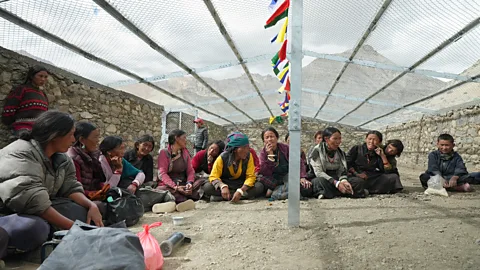 Tshiring Lhamu Lama
Tshiring Lhamu LamaDespite Tshiring's emphasis on including women in her projects, most conservation groups and committees in Nepal remain male-dominated. The participation of women is hampered by a female literacy rate in the areas Tshiring works, of around 37-40%, compared to a national average of 69% for Nepali women. According to Justine Shanti Alexander, country director of wildlife conservation organisation WCS Mongolia, women remain under-represented in many conservation projects across all countries with snow leopard habitats.
"Women in pastoral communities possess specialised knowledge and play critical roles in livestock management and natural resource use," Alexander says. "Their insights into human-wildlife interactions, especially regarding livestock predation by snow leopards, are valuable for effective conservation strategies."
Alexander emphasises that women should be empowered to take on leadership roles in conservation, and become involved in local projects set up by others.
Overall, she argues that the focus of snow leopard conservation should be on supporting the whole community to develop decision-making capacities and take ownership of projects. "In my experience, this approach can lead to improved conservation outcomes for snow leopards, and increase their sustainability," Alexander says.
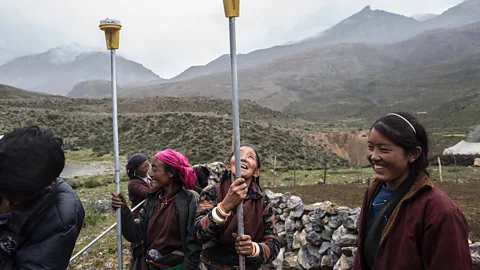 Tshiring Lhamu Lama
Tshiring Lhamu LamaPhunjok Lama agrees that such initiatives must be embedded in communities, where trust and an understanding in the process may develop gradually over time. A long-term presence is crucial, he maintains. "If I have built trust with the community, and made them understand the value of conservation, they will have the ambition by themselves," he explains.
Back in Dolpa, Tshiring has plans for 11 more predator-proof corrals in prime snow leopard areas. However, challenges remain. Transporting the necessary materials is expensive and accounts for most of the total cost of these interventions. Projects depend on the availability of international funding, and a lack of skilled human resources in the area means training also requires significant investment.
Tshiring says that introducing large-scale tourism is not her aim, as it risks disrupting the delicate habitat here. A relatively small number of visitors per year still has the potential to support both the snow leopards and the livelihoods of locals in Dolpa, without leading to degradation of the natural environment.
But for now, she can tell that local attitudes are changing. "Before the local people were looking at me as if I was an enemy. They are the guardians of their livestock, and I am the guardian of the snow leopard. And there was no crossing point," she recalls.
Now, many local people have expressed an interest in receiving spotter training, receiving a leopard-deterring light, or building a predator-proof corral.
"For me, I need to preserve both – snow leopards for the ecosystem, and livelihoods for the people," she says.
* The travel for reporting this article was partly funded by the Royal Geographic Society’s Neville Shulman Award.
--
For essential climate news and hopeful developments to your inbox, sign up to the Future Earth newsletter, while The Essential List delivers a handpicked selection of features and insights twice a week.
